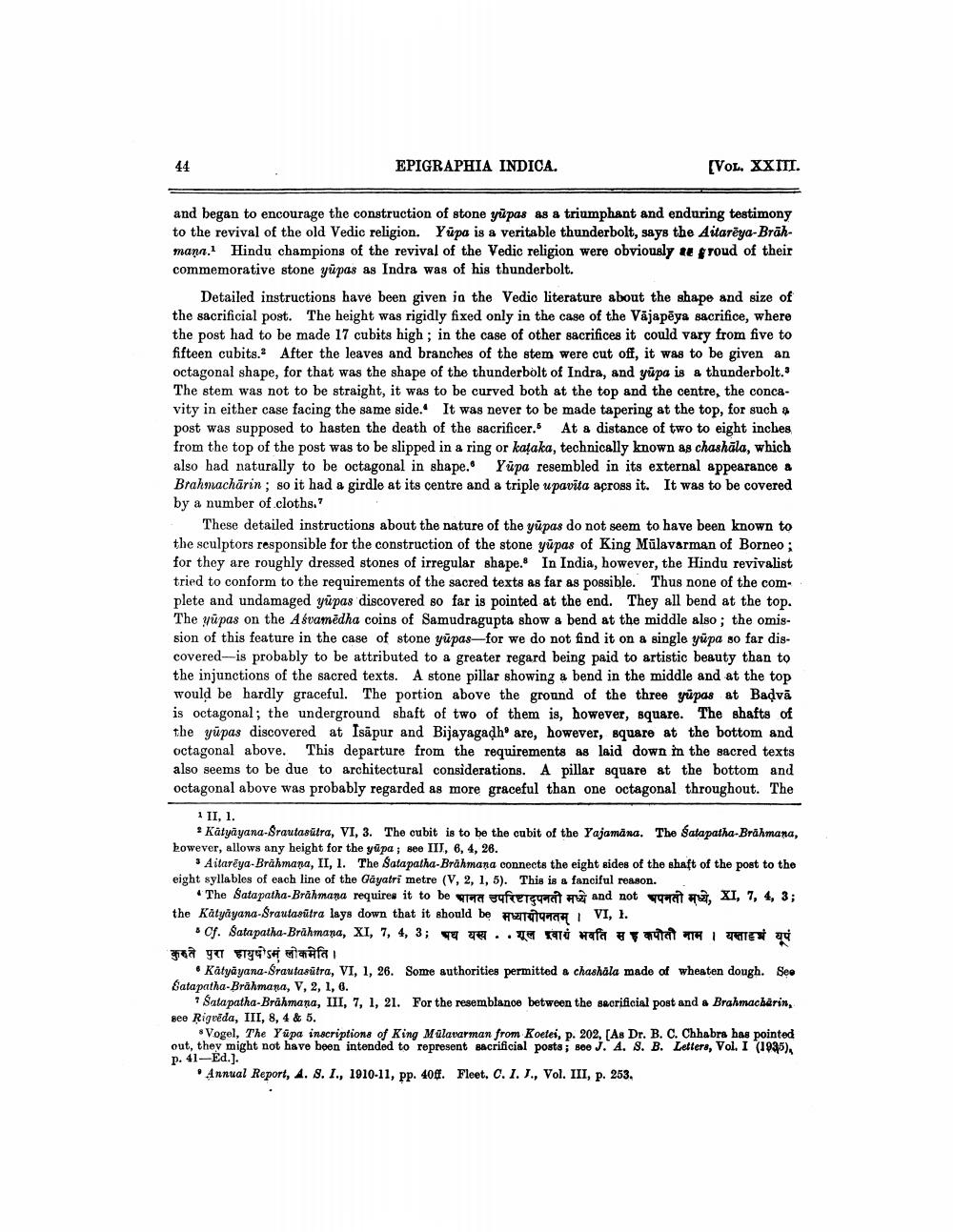________________
EPIGRAPHIA INDICA.
[VOL. XXITI.
and began to encourage the construction of stone yūpas as a triumphant and enduring testimony to the revival of the old Vedic religion. Yüpa is a veritable thunderbolt, says the Aitarēya-Brāhmana. Hindu champions of the revival of the Vedic religion were obviously te groud of their commemorative stone yüpas as Indra was of his thunderbolt.
Detailed instructions have been given in the Vedic literature about the shape and size of the sacrificial post. The height was rigidly fixed only in the case of the Vājapěya sacrifice, where the post had to be made 17 cubits high ; in the case of other sacrifices it could vary from five to fifteen cubits. After the leaves and branches of the stem were cut off, it was to be given an octagonal shape, for that was the shape of the thunderbolt of Indra, and yūpa is a thunderbolt. The stem was not to be straight, it was to be curved both at the top and the centre, the concavity in either case facing the same side. It was never to be made tapering at the top, for such a post was supposed to hasten the death of the sacrificer. At a distance of two to eight inches from the top of the post was to be slipped in a ring or kațaka, technically known as chashāla, which also had naturally to be octagonal in shape. Yüpa resembled in its external appearance a Brahmacharin; so it had a girdle at its centre and a triple upavita across it. It was to be covered by a number of cloths.? - These detailed instructions about the nature of the yūpas do not seem to have been known to the sculptors responsible for the construction of the stone yūpas of King Mūlavarman of Borneo; for they are roughly dressed stones of irregular shape. In India, however, the Hindu revivalist tried to conform to the requirements of the sacred texts as far as possible. Thus none of the complete and undamaged yūpas discovered so far is pointed at the end. They all bend at the top. The yūpas on the Asvamēdha coins of Samudragupta show a bend at the middle also; the omission of this feature in the case of stone yūpas-for we do not find it on a single yüpa so far discovered-is probably to be attributed to a greater regard being paid to artistic beauty than to the injunctions of the sacred texts. A stone pillar showing a bend in the middle and at the top would be hardly graceful. The portion above the ground of the three yüpas at Badvā is octagonal; the underground shaft of two of them is, however, square. The shafts of the yüpas discovered at Isāpur and Bijayagadho are, however, square at the bottom and octagonal above. This departure from the requirements as laid down in the sacred texts also seems to be due to architectural considerations. A pillar square at the bottom and octagonal above was probably regarded as more graceful than one octagonal throughout. The
1 II, 1.
: Katyāyana-Srautasūtra, VI, 3. The cubit is to be the cubit of the Yajamana. The Satapatha-Brähmana, however, allows any height for the yupa; see III, 6, 4, 26.
Aitarēya-Brāhmana, II, 1. The Satapatha-Brāhmaṇa connects the eight sides of the shaft of the post to the eight syllables of each line of the Gayatri metre (V, 2, 1, 5). This is a fanciful reason.
The Satapatha-Brähmana requires it to be a fetuar and not worth, XI, 7, 4, 3; the Katyayana-Srautasūtra lays down that it should be
4 VI, 1. Cf. Satapatha-Brahmana, XI, 7, 4, 3; Y T ..
Hafa y a 76 I EN 9 कुरुते पुरा हायुषोऽम लोकमेति।
Katyāyana-Srautasūtra, VI, 1, 26. Some authorities permitted a chashala made of wheaten dough. See Satapatha-Brāhmana, V, 2, 1, 6.
Salapatha-Brahmana, III, 7, 1, 21. For the resemblance between the sacrificial post and a Brahmacharin, Bee Rigvēda, III, 8, 4 & 5.
Vogel, The Yüpa inscriptions of King Mülavarman from Koetei, p. 202, [As Dr. B. C. Chhabra has pointed out, they might not have been intended to represent sacrificial posts; 800 J. A. S. B. Letters, Vol. I (1995). p. 41-Ed.).
Annual Report, 4. 8. 1., 1910-11, pp. 40ff. Fleet. C. 1. J., Vol. III, p. 253.




